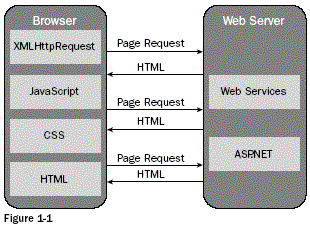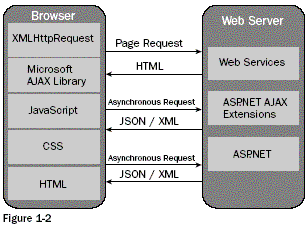|
Why End Users Want AJAX Applications
Why Developers Want AJAX
Who Benefits from AJAX?
AJAX offers benefits to both end users and developers. For end users, it reduces
the “rich or reach” conflict; for developers, it helps in overcoming the
constraints raised by HTTP.
Why End Users Want AJAX Applications
Users tend to view desktop applications as a sort of commitment. They install a
program, usually from a disk pulled from a costly shrink-wrapped box. The
program consumes hard disk space as well as a position in the program menu. The
user may need to update the program periodically or perform an upgrade later on
to get new features. If the program is proactive about updating itself, the
user is confronted regularly with dialogs about accepting patches or downloads.
In exchange for this investment of time, money, and energy, the user gets
repaid by an application that is able to leverage the operating system and
machine resources. It is a rich application. It has local storage capabilities,
offers quick response times, and can present a compelling and intuitive
graphical user interface.
|

Book Excerpt: Developing Next-Generation Web Applications
Chapter Contents
This excerpt from
Professional ASP.NET 2.0 AJAX by Matt Gibbs, Dan Wahlin, is
printed with
permission from Wrox Publication.
|
More and more applications are accessible from the web browser, where the full
resources of the hardware and OS are not available, but the user commitment of
a desktop application is not required. Over the years, interacting with a web
application has meant a predictable pattern for users. They click a link in the
page and the browser flashes while the user waits until the screen is repainted
(the dreaded post back). This cycle is repeated again and again. The user looks
at what is presented on the page, interacts with it, and clicks somewhere. The
browser produces an audible click for feedback and begins to post back to the
server. The screen of the web browser flashes blank and some icon spins or
flashes while the user waits for a new version of the page to be returned from
the server. Many times, the new version of the page is almost exactly the same
as the previous version, with only part of the page being updated. And then the
cycle begins all over again. This has a sluggish feeling even when the user has
a highspeed network connection.
The AJAX set of technologies has changed what users expect from web
applications. JavaScript code running in the browser works to exchange data
with the web server asynchronously. There is no click sound and the browser
does not flash. The request to the server is nonblocking, which means the user
is able to continue viewing the page and interacting with it. The script gets
the updated data from the server and modifies the page dynamically using the
DHTML coding methodology. The user is able to continue looking at the page
while parts of it are updated in the background. AJAX is used to provide a more
responsive experience, making web applications behave more like desktop
installations. JavaScript is used to provide a richer experience with support
for drag-and-drop, modal dialogs, and seemingly instantaneous updates to
various parts of the page based on user inputs.
A big part of successfully leveraging AJAX technologies is in the perceived
performance increase. Users appreciate web applications that anticipate their
actions. If you also use JavaScript code in the background to pre-fetch images
and data that may be needed, users can get a speedy response without the usual
pause that accompanies their actions. Nobody wants to wait for data exchanges
between client and server; studies have shown that a time lag between user
input and subsequent UI changes can significantly reduce their productivity and
give them the frustrating feeling that they are fighting the application. Users
want web applications to behave like desktop installations but without the
overhead associated with an installation. As more applications employ smart
caching, anticipate user actions, and provide richer UI, the difference between
web and desktop applications is becoming blurred. Expectations of web
applications are rising. The end user has now seen that it is possible to avoid
the commitment of installing a desktop application and still have a rich and
responsive experience.
Why Developers Want AJAX
Often, the first question to arise when starting a new development project is
what type of application it will be. Should it be a desktop application or a
web application? This is a key decision because it has historically dictated a
lot about the nature of the application and the development problem space. Many
developers are now choosing to build web applications by default unless
something about the application dictates that it must be a desktop install. If
it must run offline or if it requires a user interface that is complex to
achieve in HTML, targeting the web browser may be ruled out, and the choice to
write a standalone application is forced.
Developers have a difficult job writing modern web applications due to the
inherent worldwide-web functionality constraints imposed by the use of the
Hypertext Transfer Protocol (HTTP) and the way browsers use it. HTTP is a
stateless protocol. The web browser requests a page, possibly carrying some
querystring or form input parameters, and the server processes the request and
sends a response that includes HTML-rendered content. The server can only react
to the information supplied in the current request and doesn’t know, based on
the information in the request itself, details about the path the user took to
get to the current view. When the response is rendered, the connection may be
broken and the server won’t have any information to preserve for the next
request. From the server’s perspective, it is simply listening for requests to
come in from any browser anywhere and then reacting. The browser issues a
request to the page and receives an HTML page in response. It uses the HTML it
receives to render the user interface. The user interacts with the page, and,
in response, the browser clears the screen and submits a new request to the
server, carrying some information about user input or actions. Again, a
complete HTML page is returned. The browser then presents the new version of
HTML. Fundamentally, the HTTP protocol is stateless. The server gets a request
and responds to it. The request carries limited information about the ongoing
conversation that is happening between client and server.
AJAX makes this much better. AJAX breaks this pattern by updating portions of
the page separately, via partial page rendering. Figure 1-1 shows a typical
non-AJAX series of browser and server interactions. Each request results in a
full page rendering, and, in response, the browser updates the user’s entire
view.

In Figure 1-2, AJAX is employed to improve the user’s experience. A request is
made for the initial page rendering. After that, asynchronous requests to the
server are made. An asynchronous request is a background request to send or
receive data in an entirely nonvisual manner. They are asynchronous because the
user interface isn’t frozen during this time, and users can continue
interacting with the page while the data transfer is taking place. These calls
get just an incremental update for the page instead of getting an entirely new
page. JavaScript running on the client reacts to the new data and updates
various portions of the page, as desired. The number of requests to the server
may be no different, or in some cases there may actually be more calls to the
server, but the user perception is that the application feels more responsive.
They aren’t forced to pause, even if it’s only a slight pause, and wait for the
server while staring at a blank browser screen.

Almost a decade ago, the Microsoft Exchange Server team created an ActiveX
control called XmlHttpRequest that could be instantiated from JavaScript and
used to communicate with the server. This can occur without clearing the screen
to paint a whole new page. Using the XmlHttpRequest object, you could send
information to the server and get data back without requiring a whole new HTML
page. JavaScript code could then manipulate the HTML dynamically on the client,
avoiding the annoying flash and the wait that users associate with web
browsing. This functionality was not limited to Internet Explorer for long.
Soon, other browsers included XmlHttpRequest objects as well. Developers could
now write richer applications with reach extending across various operating
systems.
The browsers also created an advanced DOM (Document Object Model) to represent
the browser, the window, the page, and the HTML elements it contained. The DOM
exposed events and responded to input, allowing the page to be manipulated with
script. Dynamic HTML (DHTML) opened the door to writing rich interfaces hosted
within the web browser. Developers started writing hundreds and even thousands
of lines of JavaScript code to make rich and compelling applications that would
not require any client installation and could be accessed from any browser
anywhere. Web applications began to move to a whole new level of richness.
Without AJAX libraries, you would be faced with writing lots and lots of
JavaScript code and debugging the sometimes subtle variations in different
browsers to reach this new level of richness.
More Related links
Answer - ASP.NET Ajax Framework is used for implementing the
Ajax functionality......
Answer - Back functionality cannot work because the dynamic
pages don’t register themselves to the browsers history engine..........
This article
includes brief about ASP.NET, advantages of ASP.NET, navigation
sequence of ASP.NET web form, web Form components, .NET framework,
event handlers in ASP.NET, web form events, server control events in
ASP.NET, and server controls vs. HTML controls, validation controls,
navigation, and steps to store cookies, ways to authenticate and
authorize users in ASP.NET etc.
This article describes ASP.NET application
life cycle
|